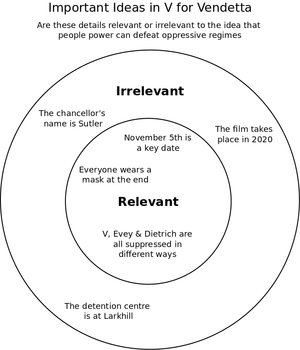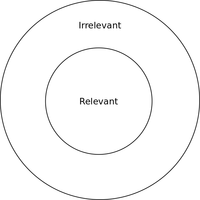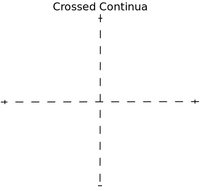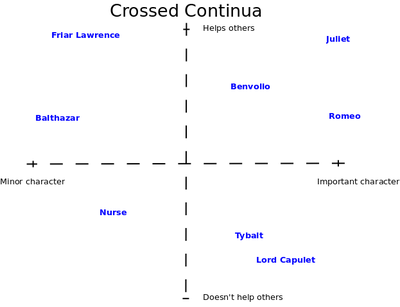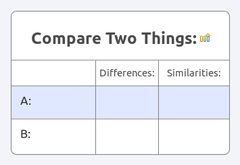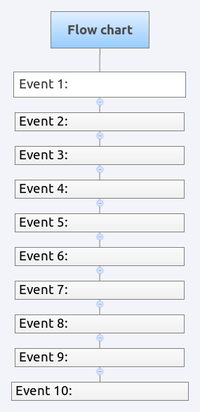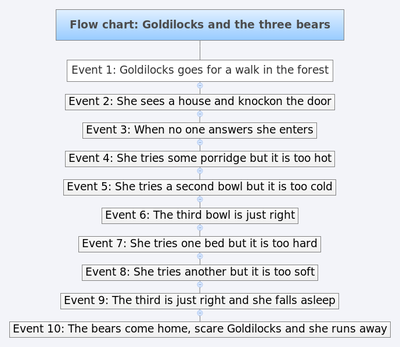Scaffolds
Contents
Test yourself
Use these templates to help develop your understanding of texts you are reading.
- Plot: flow diagram
- Important event/turning point: cause and effect
Cause and effect
Often in a film or novel, there is a central event that changes the plot or affects the characters in some way. There are often smaller, contributing events that lead up to the main event, which can be described as 'causes' of the event. The main event will also result in a series of consequences for characters, relationships and the plot. Use this cause and effect diagram to identify the causes and the effects of the central event.
| Here is an example of a cause and effect diagram, using the Shakespearean play 'Romeo and Juliet'. One of the central events in the play is the death of the character of Mercutio. This occurs during a fight between two warring families and leads to Romeo being sent away from the city of Verona. This sets off a chain of events that leads to the two main characters taking their own lives. |
- Download original file: File:Cause-and-effect-diagram.mm
Fishbone map
Test your understanding of character change:
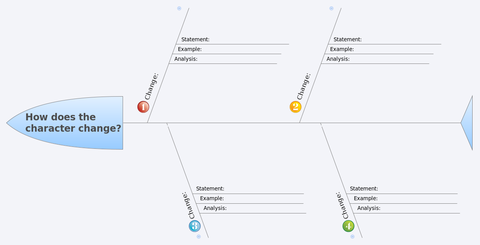
Target map
A target map is very useful for identifying things that are important from things that are not important. Place all of the important details in the centre of the map, and all of the less-important details in the outer circle. Examples of how you might use this to deepen your understanding of a text might be:
- Important details about a character
- Settings that are significant
- Relationships that are key to the main character
- Decisions that reveal important aspects of character
Which of the following details are important when getting to know someone, and which are less important? Place them into a target map.
|
Crossed continua
A continuum is a line that runs between two opposite ideas, for instance from hot to cold or soft to hard. A good way to analyse and compare characters is to plot them along a continuum, such as from kind to selfish, or from powerful to powerless. Using two continua adds more to your analysis of character, allowing you to compare powerful, selfish characters with powerless, selfish characters for instance. Choose two different continua and plot as many characters as you can think of using the two lines as axes.
| This crossed continua map plots a number of different characters against the axes of helpfulness and importance to the play. For instance, Juliet is an extremely important character who also helps others a lot, while her Nurse is less important and less helpful to others.
|
Compare and contrast
Compare and contrast two characters, settings, relationships or ideas in a novel or film you have studied. How is character A similar to/different from character B?
| Similarities | Differences | |
|---|---|---|
| Item A: | ||
| Item B: |
| Similarities | Differences | |
|---|---|---|
| Item A: Orange |
|
|
| Item B: Apple |
|
|
Download original file: File:Compare-and-contrast-map.mm
Flow chart
A flow chart helps you to identify the key events in a text and put them in the right order. Start with identifying the 10 most important events in a text. Even this is a useful process to go through, as you identify the more important (characters meeting for the first time, or achieving something significant) from the less important (someone having lunch or tying their shoelace). Once you have identified these key events, put them into the correct order.- Download original file: File:Flow-chart-map.mm
Test others
One of the best ways to learn something is to teach others. A great way to learn more about the texts you are studying is to create a set of quizzes to test someone else's knowledge
Label
Describe six characters from your text: use one adjective (describing word) and one noun (naming word) eg:
Group
Ask a partner to group characters together using labels you have made up: related to other characters, supportive of the main character, harms another character, changes over the course of the text.
Match
Create a list of settings in your text and match them with an event that happens at that setting. Once you have created these two lists, jumble up the settings and events and ask a partner to match them up. Can they put the event next to the right setting?


